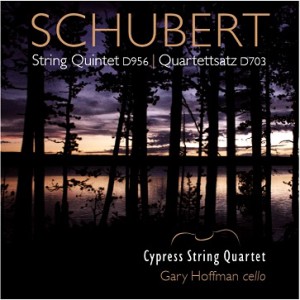Examiner.com: Avie Records releases a new Cypress String Quartet recording of Schubert
Source: examiner.com
May 12, 2014
by Stephen Smoliar
 Tomorrow Avie Records will release its latest recording (for which Amazon.com is currently taking pre-orders) of the Cypress String Quartet (CSQ), consisting of violinists Cecily Ward and Tom Stone, violist Ethan Filner, and cellist Jennifer Kloetzel. This is an all-Schubert disc featuring what is probably Franz Schubert’s most accomplished composition that did not involve a piano, his D. 956 quintet for two violins, viola, and two cellos in C major. For this recording CSQ is joined by cellist Gary Hoffman to become the appropriate quintet. The recording also includes an “encore track” of the D. 703 single movement for string quartet (“Quartettsatz”) in C minor.
Tomorrow Avie Records will release its latest recording (for which Amazon.com is currently taking pre-orders) of the Cypress String Quartet (CSQ), consisting of violinists Cecily Ward and Tom Stone, violist Ethan Filner, and cellist Jennifer Kloetzel. This is an all-Schubert disc featuring what is probably Franz Schubert’s most accomplished composition that did not involve a piano, his D. 956 quintet for two violins, viola, and two cellos in C major. For this recording CSQ is joined by cellist Gary Hoffman to become the appropriate quintet. The recording also includes an “encore track” of the D. 703 single movement for string quartet (“Quartettsatz”) in C minor.
The recording sessions took place in January of 2013 at Skywalker Sound in conjunction with the visit that Hoffman made to the Bay Area to perform D. 956 at one of the Salon Series concerts given by CSQ at several Bay Area venues each season. I should therefore state, as a disclaimer, that, having thoroughly enjoyed this work in concert, I have been looking forward to the recording since I first learned it would be produced. Since I do not play any instrument in the string family (with the possible exception of washtub bass), where D. 956 is concerned, I have had to content myself with concerts, recordings, and a major effort with a colleague to play a four-hand version of the score.
For those unfamiliar with the backstory for D. 956, Schubert completed it in September of 1928. By November 19 he would be dead. Regular readers know that I attach great significance to the final year of Schubert’s life. In an earlier article I described him during this period as “not only prodigiously productive but also adventurously imaginative.” These traits may be most vividly evident in his final three piano sonatas, D. 958 in C minor, D. 959 in A major, and D. 960 in B-flat major, all of which were also composed in September of 1828.
However, while those sonatas display Schubert’s creative approach to the keyboard, it is in D. 956 that the listener encounters just how stunning he could be in blending diverse sonorities. This is not just a question of bringing together the sounds of three different instruments, each with its own tessitura range. Rather, D. 956 suggests that Schubert understood the sonorous implications of every string on every instrument, each with its own repertoire of unique sonorities, and that he was determined to lead the attentive listener down a path astonishing not only for his convoluted logic of harmonic progression or his unfailing gift for compatibility of original melody and accompaniment but also for the very sounds through which those traits fall upon the ear.
In many ways CSQ is an ideal ensemble for D. 956. During the first rehearsals after their formation in 1996, they focused on performing Johann Sebastian Bach’s four-voice harmonizations of chorale themes, beginning with the fundamental (pun intended for the specialists) bass line, fitting the inner voices to the harmonies associated with that bass, and finally adding the theme itself in the top voice. What eventually emerged, as I observed in writing on my San Francisco site about their final Salon Series concert of the current season, was an ensemble each of whose members was highly skilled in listening to the other three, informed as much by that listening experience as by “the marks on paper on their music stands,” if not more so.
Where D. 956 is concerned, CSQ also has the good fortune of having established a musical and personal friendship with Hoffman since 1996. The result is that his own contribution to the quintet fits in perfectly with their “listening-based” approach to performance. It may be easier to appreciate this practice when one is observing it in action, but it is also strikingly evident on this new recording. Beyond the technical challenges is a four-movement composition that extends across a broad panorama of emotional dispositions, covering ecstatic mania, intense despair, and what may well be the most successful capture of Zen quietude in nineteenth-century music, if not in music history. It is through the intimate chemistry between Hoffman and CSQ that every last detail of every last form of expression can emerge with a visceral clarity.
All this poses the risk that the single movement of D. 703 may come across as an unnecessary afterthought. However, this short work also benefits from the CSQ attentiveness to sonority. The performance endows it with its own character, similar in some ways to what was later explored in D. 956 but still in its own unique voice. Still, the evidence is that D. 703 was a the first movement of a full quartet that was never written; and perhaps, on this recording, it would have been more suitable as an “overture” for D. 956, rather than a “bonus track” that risks raising those connotations of an afterthought.